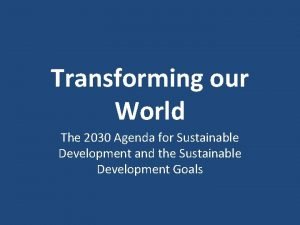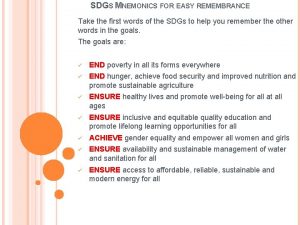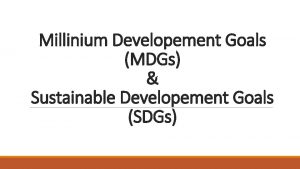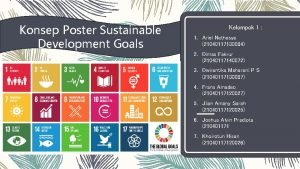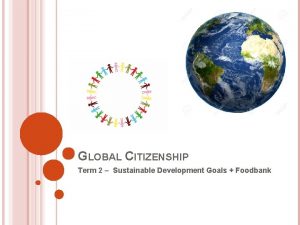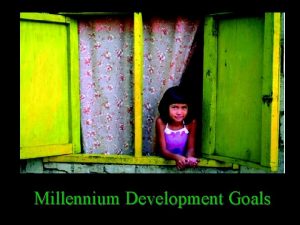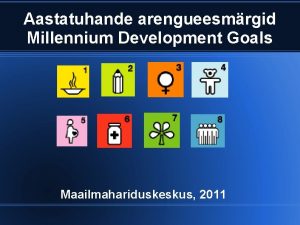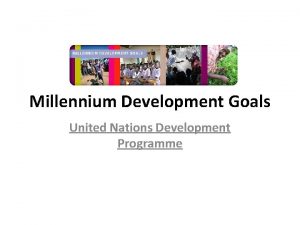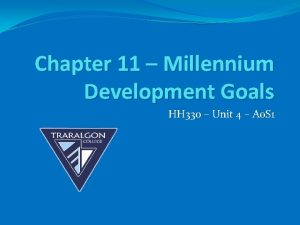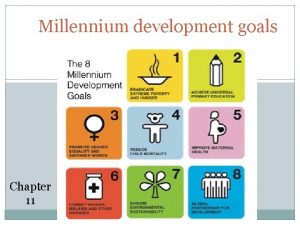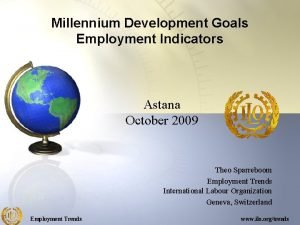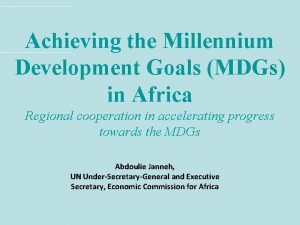Millennium Development Goals Chapter 9 Millennium Development Goals


















































- Slides: 50

Millennium Development Goals

Chapter 9 - Millennium Development Goals KEY KNOWLEDGE The eight United Nations Millennium Development Goals, their purpose and the reasons why they are important (pages 308– 41) The interrelationships between health, human development and sustainability to produce sustainable human development in a global context (pages 342– 4) KEY SKILLS • describe the eight United Nations Millennium Development Goals, their purpose and reasons why they are important (pages 345– 6) • evaluate the progress towards the Millennium Development Goals (pages 346– 7) • analyse in different scenarios the interrelationships between health, human development and sustainability (pages 348– 50).

WHY THE GOALS ARE IMPORTANT ? Millions of people in developing countries are dying or becoming ill from preventable causes such as HIV/AIDS, malaria and malnutrition. The underlying issues contributing to the high morbidity and mortality rates in developing countries include gender inequality, lack of education, lack of access to nutritious foods, lack of access to clean water and sanitation, limited or no health care and environmental degradation.

Developed countries can have a significant impact on reducing morbidity and mortality rates through fair trade arrangements, providing developmental assistance and debt relief, and ensuring access to health care and technology. The Millennium Development Goals have been developed to: Provide a framework for ensuring that significant improvements can be made in the health status and human development of populations globally.

In September 2000, many of the world’s leaders came together at the United Nations headquarters in New York and formalised the United Nations Millennium Declaration. This declaration, which was endorsed by 189 countries, recognised the importance of all countries developing global partnerships that aimed to reduce extreme poverty by 2015 through the achievement of the Millennium Development Goals (MDGs).

‘Eradicating extreme poverty continues to be one of the main challenges of our time, and is a major concern of the international community. Ending this scourge will require the combined efforts of all, governments, civil society organizations and the private sector, in the context of a stronger and more effective global partnership for development. The Millennium Development Goals set timebound targets, by which progress in reducing income poverty, hunger, disease, lack of adequate shelter and exclusion — while promoting gender equality, health, education and environmental sustainability — can be measured. They also embody basic human rights — the rights of each person on the planet to health, education, shelter and security. The Goals are ambitious but feasible and, together with the comprehensive United Nations development agenda, set the course for the world’s efforts to alleviate extreme poverty by 2015. ‘

The Goals were created by the United Nations and have the target date of 2015

KEY TERM DEFINITIONS Biodiversity- The different plants, animals and micro-organisms, their genes and the ecosystems of which they are a part Extreme poverty - People who live on less than US$1 a day Gender parity- Ensuring that males and females have equal opportunities in areas such as education, employment, voting and decision making, and access to health care and other resources Malnutrition- Medical condition caused by an improper or insufficient diet Sustainable human development- The capacity for current and future generations to achieve their full potential and lead productive, creative lives in accordance with their needs and interests


Why is Goal 1 important? Poverty means that a country does not have the economic resources to develop infrastructure and invest in education, health, political and legal systems, and public institutions. Failure to invest in these areas means that people are unable to improve their lives and escape the cycle of poverty. How does poverty impact on individuals? Not being able to purchase the quality of food needed to sustain life. Not being able to access the required health care to treat a preventable illness.

Target 1 Halve, between 1990 and 2015, the proportion of people whose income is less than US$1 a day

There are two ways to measure a countries wealth what are they? The percentage of the population who live on less than US$1 a day, which is referred to as extreme poverty. Measuring extreme poverty enables comparisons to be made between countries to determine the relative level of poverty within a country. Gross domestic product (GDP). GDP refers to the total value of all goods and services produced by a country. This is divided by the total population in order to get an indication of average income. GDP measurement enables comparisons to be made between countries, including both developing and developed countries. This provides an indication of relative poverty on a global scale.

Target 2 Achieve full and productive employment and decent work for all, including women and young people

List the limitations to employment that impact on women’s health Women are required to be the Caregivers within families and perform all domestic duties, including growing food or carrying water long distances. Jobs, involving hard labour, and the heavy workload can be detrimental to their health. Paid less than men even though they may be required to perform the same duties. Limited Education impacts significantly on the opportunities to be employed in higher paid positions. Cultural constraints, women have limited legal rights, lack opportunities for training and for land ownership and access to credit.

List the limitations to employment that impact on children’s health Limited Education Often forced into Child Labour, where they are required to work long hours in environments that are not regulated to ensure their safety. Many children die as a result of unsafe work practices, or suffer lifelong physical damage which impacts on their capacity to earn an adequate income in the future, thereby continuing the cycle of poverty into the next generation.

Target 3 Halve, between 1990 and 2015, the proportion of people who suffer from hunger

Define…. Hunger Malnutrition The continuing deprivation in a person of the food needed to support a healthy life. A lack of specific nutrients required for the effective functioning of the body. An individual may have the required quantity of food to sustain life but they may not be consuming the required range of nutrients, which may put them at risk of diseases such as iron-deficiency anaemia.

MDG 1 target 1 Improvements Ongoing concerns • Rates of poverty and the number of people living in extreme poverty have fallen in every developing region. Target 1: Halve between 1990 and 2015 the proportion of people whose income is less than US$1. 25 a day • A significant proportion of • The halving of extreme poverty rates will be achieved the global population will still at the global level by 2015. be living in extreme poverty. • Significant poverty reductions occurred in China, India, Southern Asia and sub. Saharan Africa.

MDG 1 target 2 Improvements Target 2: Achieve full and productive employment and decent work for all, including women and young people • 352 Progress in the reduction of the proportion of workers • The number of workers living in poverty has slowed. on less than $1. 25 a day has • Women and young people are declined. the most likely to be in insecure and poorly paid employment. Ongoing concerns

MDG 1 target 3 Improvements Ongoing concerns • Millions of children are still at risk of stunted development due to under-nutrition. • Even though income poverty has decreased, there has been a lack of progress in reducing hunger in • Significant reductions occurred in several developing regions. Target 3: Halve between 1990 and the proportion of children under • The number of undernourished 2015 the proportion of people who the age of five who were people increased sharply in subsuffer from hunger underweight in developing Saharan Africa due to increasing regions. food prices. • Children in rural areas and poorer children are more likely to be underweight when compared to their counterparts in urban areas and richer households.



Why is Goal 2 important? Education leads to greater employment prospects, thereby increasing levels of income. This in turn improves the individual’s capacity to access adequate nutrition, shelter and health care, not only for themselves but also for their family members. Those who are educated are more likely to understand health-related information, which is vital for promoting positive health behaviours. Often in developing countries, governments do not have the funding to provide education for all children and, as a result, schooling is only available for those who can afford to pay for it. Through achieving primary education for all children, the opportunities for individuals to improve their standard of living, develop to their full potential and lead productive lives according to their needs and interests are greatly improved. Those who are educated are more likely to ensure that their own children are educated.

What is the purpose of Goal 2? Achieve universal primary education Is to provide both boys and girls in developing countries with access to primary schooling to improve literacy and numeracy skills. It also offers opportunities to gain the skills and knowledge to engage in health-promoting behaviours.

Target 1 Ensure that by 2015, children everywhere, boys and girls alike, will be able to complete a full course of primary schooling

Measuring the success of Goal 2 MDG 2 target Improvements Ongoing concerns Ensure that by 2015 children everywhere, boys and girls alike, will be able to complete a full course of primary school. • Gender parity has been achieved in the enrolment rate of girls and boys in primary education. • Enrolment rates of primary school aged children have increased in sub. Saharan Africa. • Excluding sub-Saharan Africa, more than 90 per cent of primary school aged children are enrolled in school. • Globally, the proportion of females out of school has declined. • The percentage of students finishing the last year of primary school has increased. • In all areas except for sub-Saharan Africa, girls and boys have similar chances of completing primary education. • The proportion of young people who can read and write a simple statement about their daily life has increased • The proportion of literate young women has increased. • There is still a significant proportion of children in developing regions who are not attending school. • In some regions, females make up a significantly larger proportion of the children who are out of school. • In sub-Saharan Africa, boys are more likely to complete primary education. • In sub-Saharan Africa, a significant proportion of children who complete primary school do not continue on to secondary school. • A significant proportion of adolescents are out of school globally. • Young adolescents from the poorest households are more likely to be out of school compared to those from the wealthiest households. • There is still a significant proportion of young people who are unable to read or write a short, basic statement about their daily life.



Why is Goal 3 important? Females are generally less likely than males to have access to education. Education has the ability to empower women; it enables them to access higher paid employment and work in jobs that are less likely to impact negatively on their health. As the traditional primary caregivers of families, it is important for women to develop their knowledge regarding health-related behaviours, including the skills to be able to read and understand health information. The numeracy and literacy skills taught in schools may also assist women in developing a personal business. With greater income, women are able to exert more control over their lives and make decisions that are in their best interest and those of their families.

What is the purpose of Goal 3? To raise the socioeconomic status of women in developing countries through ensuring that females have equal access to education. This goal also aims to empower women through ensuring their involvement in decision making processes that affect themselves, their families, their communities and their countries.

Target 1 Eliminate gender disparity in primary and secondary education, preferably by 2005, and in all levels of education by no later than 2015

Outline 5 factors that contribute to decreased attendance rates by women in education Drought, food shortages, armed conflict, poverty, child labour and HIV/ AIDS, lack of access to water and sanitation results in females spending significant proportions of the day fetching water. Lack of private and decent sanitation facilities also impacts on girls’ enrolment at school. Families are less likely to send their female children to school if separate and private toileting facilities are not provided for girls. For families with limited income, male children are often provided with educational opportunities before their female siblings.

Measuring the success of Goal 3 MDG 3 target Improvements Ongoing concerns Globally, gender parity has been achieved in the enrolment rates of girls and boys in primary education. The proportion of girls enrolled in primary education has increased significantly in sub-Saharan Africa and Western Asia. Western and Southern Asia had the greatest gains in the enrolment of girls in secondary school. Eliminate gender disparity in primary and secondary education, preferably by 2005, and in all levels of education by no later than 2015. In Latin America and the Caribbean, more girls than boys were enrolled in secondary school. In developing regions, significant gains were made in terms of the enrolment of females in tertiary education. Globally, the proportion of women in paid jobs outside of the agricultural sector increased. Increases have occurred in the number of women obtaining top positions in parliament. Not all countries in developing regions had achieved equivalent rates of girls and boys enrolled in primary education. Girls from the poorest households face the greatest barriers to education. Only a relatively small proportion of senior management positions are held by women. Women tend to hold lower paid jobs, in a narrower range of occupations. Women more often than men work in informal employment without social protection and lacking entitlement to employment benefits such as paid annual leave or sick leave. The proportion of women holding parliamentarian seats remains low. The number of countries with women as head of government, head of state or both has remained low. Violence against women is undermining efforts to achieve all Millennium Development Goals.



Why is Goal 4 important? Most causes of U 5 MR in developing countries can be prevented or treated by inexpensive means. Some of the most deadly causes of disease, such as measles, can be vaccinated against. The risk of diarrhoea can be reduced through breastfeeding and using good hygiene and sanitary practices, and providing access to clean water. Other conditions such as pneumonia can be treated with antibiotics. More than 10 million children under the age of five die annually and more than 20 million children under the age of five are severely malnourished (WHO, 2009). As children represent the future, it is the responsibility of the global community, including governments, to promote their health and reduce the child mortality rate.

What is the purpose of Goal 4? To reduce the number of deaths of children under the age of five (U 5 MR).

Target 1 Reduce by two-thirds, between 1990 and 2015, the under-five mortality rate.

Identify 5 preventable causes of death that contribute to U 5 MR Diarrhoea Pneumonia Measles Malnutrition Neonatal Causes Sepsis Congenital anomalies Tetanus malaria

MDG 4 target Reduce the under-five mortality rate by two-thirds between 1990 and 2015. Improvements Ongoing concerns • Globally, significant reductions have occurred in the under-five mortality rate. • Within developing regions, progress on reducing underfive mortality rate has accelerated. • Accelerated efforts to reduce measles deaths have resulted in a decrease in global measles mortality. • Significant reductions have occurred in the percentage of measles deaths in sub-Saharan Africa due to increased immunisation coverage and large-scale immunisation programs. • Sub-Saharan Africa and Oceania have not achieved the reductions required to meet the target. • Sub-Saharan Africa and Southern Asia make up a large proportion of the world total of under-five mortality. • The rate of reduction in neonatal mortality has declined over the past two decades. • Children from rural areas in developing regions are at a disadvantage with regards to living past their fifth birthday. • Children from the poorest households are more likely to die before their fifth birthday compared to children from the wealthiest households. • Millions of children in developing regions did not receive the vaccine against measles. • There was an increase in reported measles cases in 2010, and large outbreaks were reported in Africa, the Eastern Mediterranean, Europe, Eastern and South-Eastern Asia, and Oceania.



Why is Goal 5 important? Improving maternal health is important for both the mother and the child, as well as the entire community. Reducing the risk of complications during pregnancy and childbirth significantly reduces the maternal mortality rate. Maximising the health of mothers enables them to continue in their caregiving role, not only for the newborn child but also for other family members. Providing access to reproductive health services means that women are better able to take care of themselves and their children through seeking advice and treatment, as well as being able to plan the timing and spacing of births.

What is the purpose of Goal 5? The purpose of goal 5 is to improve maternal health by reducing the number of deaths of women that occur as a result of pregnancy and childbirth and to increase access to reproductive services.

Identify 5 causes of maternal deaths Haemorrhage (excessive bleeding), Sepsis (whole body infection), Unsafe abortion, Obstructed labour (often due to a small pelvis restricting the baby from being born via a vaginal birth) and • Hypertensive disease during pregnancy. • •

In developing countries, many women and young girls of reproductive age do not have access to family-planning services, which are important for allowing individuals to plan the number of children they have and the spacing and timing of births. Family planning can ensure the family is financially able to meet the needs of an additional child, providing them with access to education and a decent standard of living (Human development). For those living in poverty, the impact of having to feed another child is often too much to bear and an abortion is considered the only alternative. In developing countries these are often unsafe, performed in unhygienic environments and by unqualified individuals and can lead to an increase in maternal mortality (Health).

MDG 5 targets Improvements Ongoing concerns • Developing regions with the highest maternal mortality had a limited proportion of births attended by skilled health personnel. • Large differences exist in terms of access to • The proportion of antenatal care in the countries in the African deliveries attended region. by skilled health • Almost half of pregnant women in personnel has developing countries did not have the Achieve by 2015, increased in minimum requirement for antenatal care as universal access to developing regions recommended by the World Health reproductive since 1990. Organization. • Antenatal care health. • The rate of decline in pregnancies in coverage has adolescents has slowed or even reversed in increased in some developing regions • Sub-Saharan Africa has the highest birth rate since 1990. among adolescents, with little progress occurring since 1990. • A significant proportion of women of childbearing age in sub-Saharan Africa did not have access to contraception in 2010.

MDG 5 targets Improvements Ongoing concerns • The maternal mortality ratio is significantly • The global maternal higher in developing Reduce by three mortality rate has regions. quarters, between 1990 declined since 1990. • Sub-Saharan Africa has and 2015, the maternal • The maternal mortality a high maternal mortality ratio in developing mortality ratio, with regions has declined. AIDS being a contributing factor.

Target 5. B: Achieve universal access to reproductive health More women are receiving antenatal care. In developing regions, antenatal care increased from 63 per cent in 1990 to 81 per cent in 2011. Only half of women in developing regions receive the recommended amount of health care they need. Fewer teens are having children in most developing regions, but progress has slowed. The large increase in contraceptive use in the 1990 s was not matched in the 2000 s. The need for family planning is slowly being met for more women, but demand is increasing at a rapid pace. Official Development Assistance for reproductive health care and family planning remains low.

 Draw a conclusion about the millennium development goals.
Draw a conclusion about the millennium development goals. Strategic goals tactical goals operational goals
Strategic goals tactical goals operational goals Strategic goals tactical goals operational goals
Strategic goals tactical goals operational goals Millennium goals 2000
Millennium goals 2000 Millennium goals 2000
Millennium goals 2000 Millennium goals 2000
Millennium goals 2000 Chapter 26 section 1 the 1990s and the new millennium
Chapter 26 section 1 the 1990s and the new millennium General goals and specific goals
General goals and specific goals Motivation in consumer behaviour
Motivation in consumer behaviour Millennium geospatial
Millennium geospatial Third millennium
Third millennium Millennium prize problems
Millennium prize problems Millennium
Millennium Innopac millennium
Innopac millennium Poincare conjecture solver
Poincare conjecture solver Ava fontaine
Ava fontaine Miles villacampa
Miles villacampa Millennium 3 financial services
Millennium 3 financial services Millennium ecosystem assessment
Millennium ecosystem assessment Whats the difference between tone and mood
Whats the difference between tone and mood Millennium
Millennium Millennium
Millennium Millennium clock tower edinburgh
Millennium clock tower edinburgh Millennium planters
Millennium planters Millennium
Millennium Us digital millennium copyright act ethics
Us digital millennium copyright act ethics Biotechnology science for the new millennium
Biotechnology science for the new millennium Tacholink
Tacholink Millennium insurance
Millennium insurance Millennium assessment report
Millennium assessment report Literary devices in sir gawain and the green knight
Literary devices in sir gawain and the green knight Millennium ecosystem assessment
Millennium ecosystem assessment Rc regensburg millennium
Rc regensburg millennium Millennium scholars program
Millennium scholars program Dependency theory ap human geography
Dependency theory ap human geography Mnemonics to remember sustainable development goals
Mnemonics to remember sustainable development goals Sustainability developement goals
Sustainability developement goals Un sustainable development goals
Un sustainable development goals Un 2015 sustainable development goals
Un 2015 sustainable development goals Poster sustainable development goals
Poster sustainable development goals Sustainable development goals
Sustainable development goals Sustainable development goals 2
Sustainable development goals 2 What is the labelling theory
What is the labelling theory Advantage and disadvantage of observation method
Advantage and disadvantage of observation method History of community work
History of community work Development that ended much development crossword
Development that ended much development crossword Describe how sheet metal is used in pattern development
Describe how sheet metal is used in pattern development Child development principles and theories
Child development principles and theories Child development chapter 9
Child development chapter 9 Chapter 9 agricultural transformation and rural development
Chapter 9 agricultural transformation and rural development Chapter 9 agricultural transformation and rural development
Chapter 9 agricultural transformation and rural development



